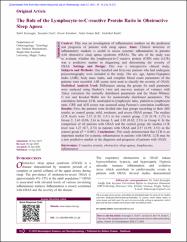| dc.contributor.author | Köseoğlu, Sabri | |
| dc.contributor.author | Ünal, Yasemin | |
| dc.contributor.author | Saruhan, Ercan | |
| dc.contributor.author | Bek, Vedat Semai | |
| dc.contributor.author | Kutlu, Gülnihal | |
| dc.date.accessioned | 2020-11-20T14:39:24Z | |
| dc.date.available | 2020-11-20T14:39:24Z | |
| dc.date.issued | 2020 | |
| dc.identifier.issn | 2636-865X | |
| dc.identifier.uri | https://doi.org/10.4103/NSN.NSN_24_20 | |
| dc.identifier.uri | https://hdl.handle.net/20.500.12809/420 | |
| dc.description | 0000-0001-6416-1442 | en_US |
| dc.description | WOS: 000574527400004 | en_US |
| dc.description.abstract | Context: This was an investigation of inflammation markers on the prediction and prognosis of patients with sleep apnea. Aims: Clinical detection of inflammatory markers is useful to assess systemic inflammation in patients with obstructive sleep apnea syndrome (OSAS). The aim of the study was to evaluate whether the lymphocyte-to-C-reactive protein (CRP) ratio (LCR) was a predictive marker in diagnosing and determining the severity of OSAS. Settings and Design: This was a retrospective clinical study. Subjects and Methods: One hundred and forty-one patients who had undergone polysomnography were included in the study. The sex, age, Apnea-Hypopnea Index (AHI), body mass index, and complete blood count parameters of the patients were recorded. AHI scores were used to classify the severity of OSAS. Statistical Analysis Used: Differences among the groups for each parameter were analyzed using Student's t-test and one-way analysis of variance with Tukey correction for normally distributed parameters and the Mann-Whitney U test and Kruskal-Wallis test for nonnormally distributed parameters. The correlation between LCR, neutrophil-to-lymphocyte ratio, platelet-to-lymphocyte ratio, CRP, and AHI scores was assessed using Pearson's correlation coefficient. Results: First, the patients were divided into four groups according to their AHI results, as control group, mild, moderate, and severe OSAS groups. The median LCR levels were 2.57 (1.59, 3.51) in the control group, 1.28 (0.74, 3.27) in Group 2, 1.63 (0.86, 2.6) in Group 3, and 1.05 (0.62, 2.31) in Group 4. In the comparison of all patients with OSAS and the control group, the median LCR level was 1.27 (0.7, 2.74) in patients with OSAS and 2.57 (1.59, 3.51) in the control group (P = 0.002). Conclusions: This study demonstrated that LCR is an important marker for systemic inflammation in patients with OSAS. LCR may be a new predictive marker in the diagnosis and prognosis of patients with OSAS. | en_US |
| dc.item-language.iso | eng | en_US |
| dc.publisher | Wolters Kluwer Medknow Publications | en_US |
| dc.item-rights | info:eu-repo/semantics/openAccess | en_US |
| dc.subject | C-Reactive Protein | en_US |
| dc.subject | Obstructive Sleep Apnea | en_US |
| dc.subject | Lymphocytes | en_US |
| dc.subject | Inflammation | en_US |
| dc.title | The role of the lymphocyte-to-C-reactive protein ratio in obstructive sleep apnea | en_US |
| dc.item-type | article | en_US |
| dc.contributor.department | MÜ, Tıp Fakültesi, Cerrahi Tıp Bilimleri Bölümü | en_US |
| dc.contributor.institutionauthor | Köseoğlu, Sabri | |
| dc.contributor.institutionauthor | Ünal, Yasemin | |
| dc.contributor.institutionauthor | Saruhan, Ercan | |
| dc.contributor.institutionauthor | Bek, Vedat Semai | |
| dc.contributor.institutionauthor | Kutlu, Gülnihal | |
| dc.identifier.doi | 10.4103/NSN.NSN_24_20 | |
| dc.identifier.volume | 37 | en_US |
| dc.identifier.issue | 3 | en_US |
| dc.identifier.startpage | 124 | en_US |
| dc.identifier.endpage | 128 | en_US |
| dc.relation.journal | Neurological Sciences and Neurophysiology | en_US |
| dc.relation.publicationcategory | Makale - Uluslararası Hakemli Dergi - Kurum Öğretim Elemanı | en_US |


















